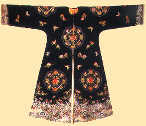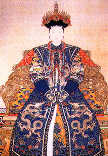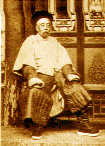 Women's dresses included court, ceremonial and casual costumes. The code of court costume was prescribed as specific dresses for women from the queen to wives or mothers of the seven-rank officials. Ceremonial costume referred to auspicious dresses and mourning apparels. Women's dress for wedding, funeral and birthday were prescribed according to their ranks. Casual costume had various styles.
Women's dresses included court, ceremonial and casual costumes. The code of court costume was prescribed as specific dresses for women from the queen to wives or mothers of the seven-rank officials. Ceremonial costume referred to auspicious dresses and mourning apparels. Women's dress for wedding, funeral and birthday were prescribed according to their ranks. Casual costume had various styles.
There was strict stipulation governing women's daily costume and the dressing styles were bound by laws. It was stipulated that servants, actors and laborers were forbidden to wear clothes made of high-grade materials, such as thread, thin silk, yarn, damask silk, satin, fabric, fine fur, fine wool, cyan materials. What's more, they were untitled to freely use pearl, jade, gold, silver, precious stones and other valuable materials as adornments. Materials of their clothes were limited to ko-hemp cloth, tatting cloth, hirsute, tussah silk, and fur of racoon dog, sheepskin and other low-grade materials.
Emperess' Court Robes in the Qing Dynasty

Winter court hats of empress dowagers and empresses were made of fumed marten and sewn with red wefts. Their hats adorned with pearl, gold pheasant patterns, gems and jade ornaments had protective collar behind the neck with drooping bright yellow ribbons. Summer court hats were made of cyan velvet.
Empress dowagers, queens and high-ranked imperial concubines used cyan sheets with gold-wrapped metal trims to decorate their court costumes; images of dragons and Chinese charactersFu(blessing) andShou(longevity) were embroidered on the clothes. The winter court robes of empress dowagers, queens and high-ranked imperial concubines were bright yellow, and also decorated with images of dragon patterns. Necklines of dresses of empress dowagers and queens were made of golden filament and decorated with pearls, turquoises and jade ornaments. Three sets of necklaces were hung on the chest when empress dowagers and queens wore court robes. When an empress dowager or queen was in auspicious clothing, she always wore one set of necklace made of pearls, jade and other top-grade materials. Court necklaces of imperial concubines were decorated with ambers, each having 108 beads in four parts divided by three big ones.
Men's Costume in the Qing Dynasty
 Men's costume mainly included long gowns and mandarin jackets, and the sleeve ends employed the horse-hoof shape for the first time. The structure of a long gown was simple, with erect collar and straight main body. Most long gowns had bigger inner piece on the right side. Both back and front parts had seams, and the lower hem might have two splits, four splits or no split.
Men's costume mainly included long gowns and mandarin jackets, and the sleeve ends employed the horse-hoof shape for the first time. The structure of a long gown was simple, with erect collar and straight main body. Most long gowns had bigger inner piece on the right side. Both back and front parts had seams, and the lower hem might have two splits, four splits or no split.
Costume of imperial nobles included long gowns with splits on four sides, facilitating shooting arrow on horseback. Long gowns of common people just had two splits on the left and right sides or had no split. The latter was clothes that people wore during entertainment. Mandarin jackets worn over long gowns did not reach the knees, and sleeves were wider and shorter. It was fashionable to wear ornaments in the Qing Dynasty.
Jackets were the most popular dress among men's costumes, and mandarin jackets were one of the four costumes of Manchu men, namely ceremonial robes, casual gowns, rain jackets and Mandarin jackets fell into several types: unlined single-layer, interlining and cotton. They were usually azurite, dark purple or black. Top-grade mandarin jackets in the Qing Dynasty was the Yellow Mandarin Jacket, which was the highest reward from the emperor and only four types of people were entitled to get it: trusted subordinates of the emperor, ministers who presented rare birds or beasts to the emperor, senior officials with great contribution to war, and court envoys.
Mandarin jackets had either long or short sleeves, which were both loose.










